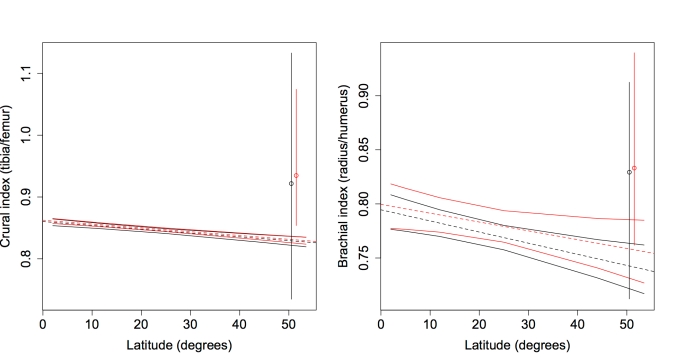This semester I have added a lab component to my Introduction to Biological Anthropology class. Lab activities and assignments provide students with opportunities to gather data, to think about them in the context of various theories, and to learn about how to analyze them. This past week’s lab looked at limb proportions within our classroom, in the context of “Allen’s rule” – in colder climates, animals tend to have relatively shorter distal limbs (radius+ulna and tibia+fibula). Allen’s rule, along with “Bergmann’s rule,” describe ecogeographic variation in humans and other animals: body size (i.e., mass) and shape (i.e., limb proportions) tend to vary with climate, such that populations living in colder environments tend to have less surface area relative to body mass, as an adapation to retain body heat.
A simple and effective way to quantify the relative lengths of limbs is through ratios: in this case we examined the crural and brachial indices. Here I’ve plotted average human indices against latitude as reported in a recent paper by Helen Kurki and colleagues (2008):

Human limb proportions related to latitude, as a proxy for climate. Left: Crural index (tibia length/femur length). Right: Brachial index (radius length/humerus length). Higher indices mean relatively longer tibia or radius. Data from Kurki et al. (2008). Black=female, red=male. Dashed lines are least squares regression lines for each sex, and solid lines indicate the 95% confidence limits of the regression lines. How well will our class’s data fit these models?…
These plots are consistent with Allen’s rule – the distal limb segments become relatively shorter with increasing latitude. In lab, we test whether our limb proportions reflect this presumably ecogeographic pattern. Here in Astana we are at 51ºN latitude, so these regressions predict that our class should have crural indices between 0.82-0.84, and brachial indices between 0.72-0.79. How well does our class fit these model’s predictions?

…Pretty terribly. Plots are same as above, except with our class’s data added at 51º N latitude (vertical lines). In each, the vertical lines span the class’s 95% range (black=females, red=males), with the dots marking each sex’s average. Kazakhstan is huge, and students could have grown up in latitudes from 42º-55º N, but even assuming students had all come from Shymkent their distal limbs still appear much longer than expected.
These plots show that students in the class have longer distal limbs than expected – both for our latitude, and for humans generally. The poor fit of my students’ limb proportions probably doesn’t mean they’re bad humans. Instead, we probably deviate because we compared apples to oranges: the Kurki data were dry long bones measured on an osteometric board, whereas I had my students do their best to palpate and measure the maximum lengths of their own bones beneath layers of fat, muscle, skin, and clothing. Our high indices probably reflect the underestimation of humerus and femur lengths, whose most proximal points that can be palapated (greater tubercle and trochanter, respectively) lie a bit lower than the respective heads, which would have been included in the Kurki measurements.
It was interesting to review these plots with students. Even though they’re fairly new at reading graphs like these, there was an audible gasp and bewildered muttering when their own data went up on the board. I myself was surprised at these results, but I’m happy with how the exercise went. This particular ‘study’ helps students learn about ecogeography, adaptation and human variation, as well as the importance of homology and comparing like with like.
Pingback: Driving nails into the 2014 Lawn Chair | Lawn Chair Anthropology